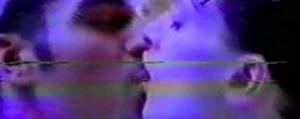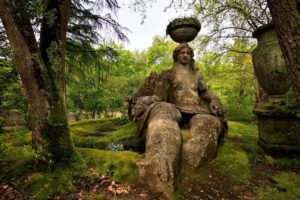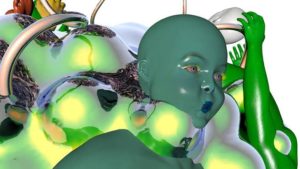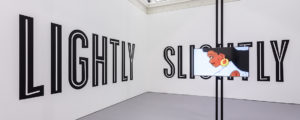Some things words don’t do justice and Flora Parrott‘s artistic practice embodies those things. A deft of touch enables her to set about sourcing objects and making prints, which then come together like poetry in describing these elliptical occurrences.
An artist run space above a pub in Peckham, the appropriately named Public House Projects recently hosted Flora’s collaborative exhibition, along with sculptor and performance artist Alan McQuillan. A break from her commissioned work, this was an opportunity for Flora to loosen up and explore new ideas, through a shared interest with Alan in phenomenological experience. The experiment fed a potent verbal and visual conversation between the two, whereby they drew inspiration from lunar cycles and British romanticist William Blake.

Entitled ‘Swell and Subside’ the installation feels sparse. The absence of matter creates an expanse that is free for contemplation, while clay and copper wires mark out imagined pathways of celestial bodies. Punctuating these trajectories, are beautifully awkward simulacra of the moon in flux, articulating the play between science and the esoteric. Sitting flanked by a window a Blake bust and the waning crescent phase; Flora delves into the politics of cosmic energy, the physical state of being and ‘stuff’.

aqnb: Your juxtaposition of materials, particularly the ones using waxy translucent materials and metal, are reminiscent of Eva Hesse. She spoke about the impermanence of her work saying, “life doesn’t last and art doesn’t last”. I get the sense she was, just as you are, trying to expand fleeting experiences…
Flora Parrott: Definitely, the interesting thing with Eva Hesse works is that they are now being so desperately preserved. But yes, the work seems to start fully in the knowledge that what I’m doing is impossible. I cant’ possibly manage to make a diagram of this moment or this feeling. You end up making a, kind of, clumsy version of this unexplainable, universal kind of thing and then it becomes totally another thing. I definitely don’t think of the works as permanent. In fact, they pretty much get taken apart and recycled and if I have to remake them, they will definitely be different. I’m very un-precious. It’s just about stuff and trying to fit them together.
aqnb: Your work is such an intuitive response to physical experience. I’m wondering if where you live and work has an impact on your practice and if you are able to identify that at all?
FP: Yeah, it definitely does. I didn’t have a studio for ages and, because I can make work wherever I am, that mirrors the configuration of whatever they happen to be. Whether they are small photographs or if I have a bit of money to make a nice big flashy print. The more anxious I am, they’ll turn out smaller… there are funny kinds of things like that, that you notice afterwards.
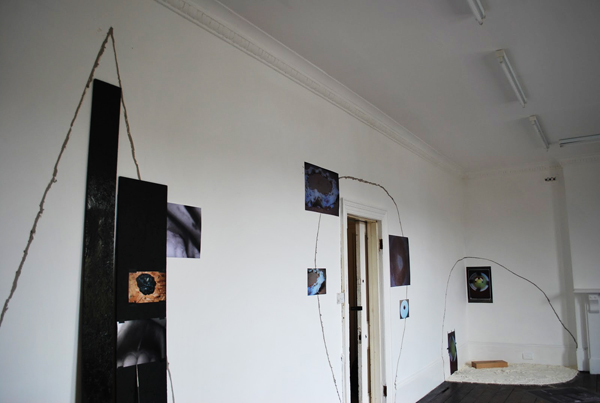
aqnb: And what about when you go away, say on holiday or for work; when you are removed from the familiar…
FP: Definitely. It’s particular moments that stick with you. I remember there was this cave I went into in South Africa, my family are from there, and it was immense. You might know what it’s like when you are in a cave and they turn the lights off and it’s just black, black, black. You could sort of scoop it up with your hand. I went away and it just stayed with me, a week later and I’m still thinking about that thing. I don’t understand it, I don’t know why it’s so interesting to me and I want to make something about that. It’s those ideas, whether it’s a moment in a space, it could be anything, it’s not necessarily natural forms. One of the pieces I used in ‘Circuit of Five Deductions’ was about pulling a snail off a piece of glass. It’s a really weird feeling, kind of magnetic, but that happened just in the city.
More recently at Wysing [Arts Centre], just sort of listening to people talking… some people can talk for hours about the most incredible stuff, but there will be one thing that just sticks with you. That’s what I want to try and work with and try and understand a bit more. So it’s pretty instinctive, I suppose.
aqnb: There was another project where you were working with the fossils in a museum…
FP: Yeah that was up in Coventry [The Herbert Art Gallery & Museum]. That was amazing, they gave us access to the fossils collection and I could use them within the sculpture. Obviously I couldn’t really touch them too much and kind of make a space around them, but they could be placed in a central position.
More recently I’ve just done an in-conversation with a man called Dr Kenneth McNamara. He’s the curator of the Sedgwick Museum in Cambridge. As well as being a writer and a professor, he’s written a book about sea urchin fossils and how that shape is really important to us; this recurring pentagonal shape. Five-sided shapes are really important to me; I often make works in fives. I mentioned that to him and he said, ‘do you know why?’ I said ‘no I don’t know why,’ and he said, ‘well, I happen to have written a book about it’. He said it’s very universal, people pick that shape out. So he’s been making this anthropological study of why people do that; why they are drawn to that pattern.

aqnb: ‘Circuit of Five Deductions’ was essentially about the five senses wasn’t it?
FP: Yes and it was based on the pentagonal shape of a vertebrae and how that shape protects the spinal column, where all this stuff goes on. That led to me working with these sea urchin fossils, which have the same five-pointed shape in them.
aqnb: I remember, during the Q&A at Tintype, you were talking about shrines and totemic relationships with objects. There’s something interesting happening in art at the moment, particularly in London. The RCA recently did ‘Ritual without Myth’, Frieze did a whole edition on ‘Religion and Spirituality’, now The Hayward is about to open ‘Invisible: Art about the Unseen’. Do you think the more science uncovers about biology and the universe, the more need there is for art to explore the things that remain a mystery?
FP: Yes, and I think the more we look inwards in society and at popular culture… I mean I feel like it’s probably cyclical, you get to a point where you don’t want to care about popular culture anymore; where you look for something a bit more meaningful, whether you dare say it or not… something about origins and all those ideas that feel kind of cranky but are really fundamental, and are the kind of questions that will never have answers.
I’m really into this book called ‘The Tao of Physics’ by Fritjof Capra, he draws parallels between eastern, ancient thinking and contemporary physics of that time [the 70s]. There’s something reinforcing about it because it’s the same stuff that everybody thinks and feels and there’s no resolution. So it’s a comforting thing to be involved with because you think, ‘well, we all think these things’ and it gives you the sense of being involved with something that has meaning and that feels important, you know? Particularly, with the relentless pace and totally impenetrable technology and all those things that are part of city life, whether that’s a cliché or not…

aqnb: I heard David Attenborough recently talking about how today we absorb the amount of information in one week that people a century ago might have been exposed to over the course of a year. I think we must be burdened by that, so I can see were the need comes from to mediate on unknowable things…
FP: Yeah and I can understand giving them physical form, as well, because they are so intangible. So to be able to pin them down in some way might enable us to relieve that burden, because it’s all just stored in this ephemeral way. If you can give it a shape and put it somewhere it doesn’t resolve it but it allows you to somehow store and order stuff and I think we probably all need to do that.


